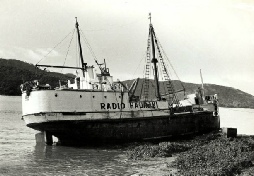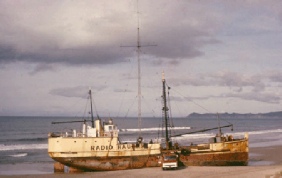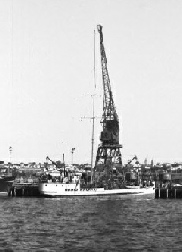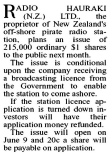© 2014-


Radio Hauraki - History (7)
The Tiri II was taken back to Whangaparapara Wharf on 9th April 1968 and se cured firmly to the wooden jetty after weather reports had forecast a severe tropical storm and 80mph winds heading towards the Hauraki Gulf area. When the storm eventually arrived it was even more severe than had been forecast and the Tiri II was wrenched from the wooden jetty, taking some bollards with her. Captain Lloyd Griffiths briefly managed to turn the ship, but she was driven helplessly onto rocks, where she was pounded continuously throughout the night. The aerial mast was destroyed during the storm and when the tide receded the stranded radio ship was left high and dry, cradled between two rocks.
cured firmly to the wooden jetty after weather reports had forecast a severe tropical storm and 80mph winds heading towards the Hauraki Gulf area. When the storm eventually arrived it was even more severe than had been forecast and the Tiri II was wrenched from the wooden jetty, taking some bollards with her. Captain Lloyd Griffiths briefly managed to turn the ship, but she was driven helplessly onto rocks, where she was pounded continuously throughout the night. The aerial mast was destroyed during the storm and when the tide receded the stranded radio ship was left high and dry, cradled between two rocks.
On the next high tide the tug Otapiri managed to pull Tiri II off the rocks and she was moored at Whangaparapara Wharf while repairs were carried out. Meanwhile Radio Hauraki returned to th e air on reduced power by running an aerial wire from the ship, along the wharf and securing it to a tree at the top of a nearby cliff about 100' above sea level. This gave the station some sort of signal while the mast from the original Tiri, which had been kept on board the new ship for just such an emergency, was erected. Tiri II was able to return to her moorings on 15th April 1968, with Radio Hauraki transmissions resuming at 6.00pm.
e air on reduced power by running an aerial wire from the ship, along the wharf and securing it to a tree at the top of a nearby cliff about 100' above sea level. This gave the station some sort of signal while the mast from the original Tiri, which had been kept on board the new ship for just such an emergency, was erected. Tiri II was able to return to her moorings on 15th April 1968, with Radio Hauraki transmissions resuming at 6.00pm.
An indication of just how important the ability to earn advertising revenue was to the station at that time came a few days later. On 21st April 1968, after being forced yet again to seek shelter in port during the night, Captain Lloyd Griffiths authorised Radio Hauraki's transmissions to start again at noon, with the vessel still in port. Every available hour the station was on the air meant there was an opportunity for income to be earned from the transmission of commercials and the risk of being caught broadcasting inside territorial limits seemed, financially at least, to be worthwhile.
Unfortunately for Radio Hauraki Post Office radio inspectors were monitoring the Tiri II's transmissions that day and, with the help of radio direction finding equipment and aerial photographs taken of the radio ship in port at the time, they managed to obtain conclusive evidence of illegal broadcasting taking place from inside New Zealand's territorial waters. Similar evidence was obtained by the Post Office on a further two occasions when the Tiri II was caught broadcasting inside territorial limits, having sought shelter from some of the worst storms in living memory.
On 13th June 1968 Captain Lloyd Griffiths decided to leave the Tiri II’s moor ing position in the knowledge of a weather forecast promising Force 9 gales and rough seas with waves of over 20'. However, the storm arrived much sooner than expected and turned out to be even more severe than forecast. At about 9.30pm transmissions were stopped and throughout the night Tiri II continued to be battered by the storm. Finally, at about 6.30am on 14th June 1968 she ran aground on Uretiti Beach, having been driven some 50 miles from her anchorage. Once again the vessel had to be rescued and towed back to Auckland for repairs, including the installation of another new 130' aerial mast. Two weeks later Tiri II sailed back to her mooring and Radio Hauraki began broadcasting again on 1st July 1968.
ing position in the knowledge of a weather forecast promising Force 9 gales and rough seas with waves of over 20'. However, the storm arrived much sooner than expected and turned out to be even more severe than forecast. At about 9.30pm transmissions were stopped and throughout the night Tiri II continued to be battered by the storm. Finally, at about 6.30am on 14th June 1968 she ran aground on Uretiti Beach, having been driven some 50 miles from her anchorage. Once again the vessel had to be rescued and towed back to Auckland for repairs, including the installation of another new 130' aerial mast. Two weeks later Tiri II sailed back to her mooring and Radio Hauraki began broadcasting again on 1st July 1968.
In September 1 968 two Bills -
968 two Bills -
Now that the legislation authorising privately owned land-
However, in August 1969 the NZBC challenged the procedures which had been followed by the Broadcasting Authority in inviting applications and obtained a Supreme Court order preventing the allocation of licences in the Auckland area. After much legal discussion had taken place about procedural technicalities it was decided that applications for the Auckland area would have to be re-


Click on picture to enlarge
Tiri II aground at Great Barrier Island
Tiri II shortly after being refloated by the tug Otapiri
Tiri II aground at Uretiti Beach
New aerial mast installed on Tiri II

History
Key Dates
Ships and Location
Technical
Staff
Programmes









Treasure Chest


Sydney Morning Herald
11th May 1969
Rock the Boat -
A documentary by Sally Aitken, which reunited the people originally involved with Radio Hauraki for the first time in 30 years to recall their battle to bring pop music programmes to the youth of New Zealand.
Featuring rare archive footage, the documentary was originally made as a student film. It was later purchased by TVNZ and screened nationally in a prime time slot.

Back to Radio Hauraki

Back to New Zealand Gallery



